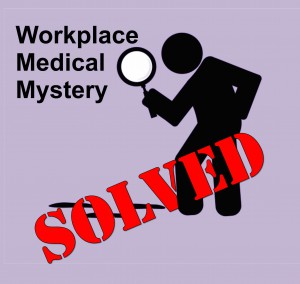Workplace Medical Mystery Solved: What Is Making This Roofer Sick?
Posted on by Ray worked as a roofer and started feeling sick during work. His symptoms started halfway through the first day and, by the end of the second day, he felt even worse with a headache, cough, shortness of breath, and chest tightness. At the doctor’s office, his tests came back normal. Read more about his case here.
Ray worked as a roofer and started feeling sick during work. His symptoms started halfway through the first day and, by the end of the second day, he felt even worse with a headache, cough, shortness of breath, and chest tightness. At the doctor’s office, his tests came back normal. Read more about his case here.
When Ray and his coworkers got sick, the roofing company ordered an investigation. On the days crew members got sick, they were placing a rubber membrane on the roof using a spray gun to apply a polyurethane foam. Investigators determined that exposure to 4,4’-Methylene-bisphenyl isocyanate (MDI) during the polyurethane foam application was causing the crew members’ symptoms.
Investigators took personal breathing zone and area air samples while crew members sprayed the foam and cleaned the spray gun. They observed the entire shift, collecting air samples on different days, and interviewed crew members. More than half of the personal breathing zone samples for MDI exceeded occupational exposure limits Eight of the 26 samples exceeded the NIOSH Recommended Exposure Limit of 50 micrograms per cubic meter (μg/m3) while 6 exceeded the NIOSH and Occupational Safety and Health Administration (OSHA) ceiling limit of 200 μg/m3. In addition, more than half (4 of 7 employees) reported symptoms consistent with isocyanate exposure.
Investigators observed poor hygiene and work practices, including improper use of respirators. Like Ray, many of the crew members took off their respirators to cool off or talk to their coworkers and some of his coworkers were not cleanshaven. Respirators must be selected, inspected, and maintained to be effective and protect workers. Certain conditions, like having facial hair and removing the respirator may expose workers to potentially hazardous levels of MDI. While Ray kept a t-shirt on, some of his coworkers went shirtless, increasing the chance of exposure through the skin. The crew wore cotton gloves, but cotton may not adequately protect workers’ hands from MDI exposure. Neoprene, nitrile, or butyl rubber gloves provide better protection against MDI. They also didn’t typically wash their hands before eating lunch or taking a smoke break.
MDI is an isocyanate. Isocyanate exposure can be through inhalation, ingestion, and absorbed through the skin. The most common adverse health outcome associated with isocyanate exposure is asthma due to sensitization. Other less common health outcomes are contact dermatitis and hypersensitivity pneumonitis. An isocyanate-exposed worker can become sensitized and develop an asthmatic condition after a single exposure, but sensitization usually takes a few months to several years. The asthmatic reaction may occur minutes or several hours after exposure, or a combination of both, but the late asthmatic reaction is the most common, occurring in approximately 40% of isocyanate-sensitized workers. After sensitization, any exposure, even to levels below an occupational exposure limit or standard, can produce an asthmatic response that may be life threatening. A worker suspected of having isocyanate-induced asthma or sensitization shows symptoms of acute airway obstruction, like:
- Coughing,
- Wheezing,
- Shortness of breath,
- Tightness in the chest, and
- Waking up at night.
A worker who was exposed to isocyanates and has similar symptoms should see an occupational medicine physician or other physician who is familiar with the health effects of isocyanate exposure. They may be experiencing negative effects from isocyanates even if their blood tests do no show antibodies indicating isocyanate exposure. Although Ray and his coworkers’ symptoms fully resolved, if anyone on Ray’s crew was sensitized, they would need to be assigned to a job that does not involve exposure to MDI. If a worker is sensitized to MDI, they could be sensitized to all isocyanates and isocyanate-containing materials. Any worker diagnosed with occupational asthma caused by MDI-containing roofing compounds should be immediately accommodated in a job that does not involve MDI exposure.
To reduce future exposures during the spraying of MDI-containing foam, Ray’s employer should:
- Work with the manufacturers of the polyurethane foam to substitute MDI with a less toxic compound.
- Install portable hand washing units in workplaces without easy access to restrooms.
- Train employees on the hazards associated with chemicals in the work environment consistent with paragraph (h) of OSHA’s Hazard Communication Standard [Code of Federal Regulations 1910.1200].
- Prohibit eating, smoking, and drinking in the work area.
- Train employees on proper respirator use. Respirators should not be removed until spraying is complete. Employees who use respirators must be clean-shaven.
- Perform quantitative fit testing of respirators. Quantitative fit testing is more objective than qualitative fit testing.
- Encourage employees to stop smoking and offer smoking cessation classes and literature on harmful effects of cigarette smoke.
- Use proper personal protective clothing, including butyl rubber gloves, neoprene, nitrile, and protective suits to decrease dermal exposures.
Workplace Medical Mysteries are fictional, however, they are loosely based on Health Hazard Evaluations (HHE) conducted by NIOSH or other reports by NIOSH. Any recommendations made were for the specific facility evaluated and may not be universally applicable and are not to be considered as final statements of NIOSH policy or of any agency or individual involved. HHEs are publicly available at https://www2a.cdc.gov/hhe/search.asp, but the names of individuals and facilities mentioned in this series have been changed to protect their identities. For more information on the NIOSH HHE program, visit www.cdc.gov/niosh/hhe/.
Emily Kirby, BPH, is a Health Communication Specialist in the NIOSH Office of Communication and Research to Practice.
Catherine C. Beaucham, PhD, CIH, is an Industrial Hygienist in the NIOSH Division of Surveillance, Hazard Evaluations, and Field Studies.
For More Information
Health Hazard Evaluation: US Roofing Contractors, Philadelphia, Pennsylvania
Posted on by

